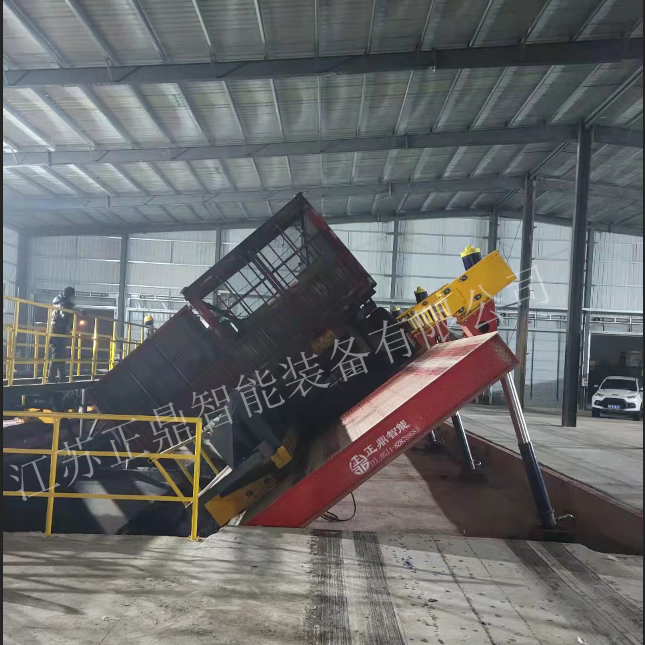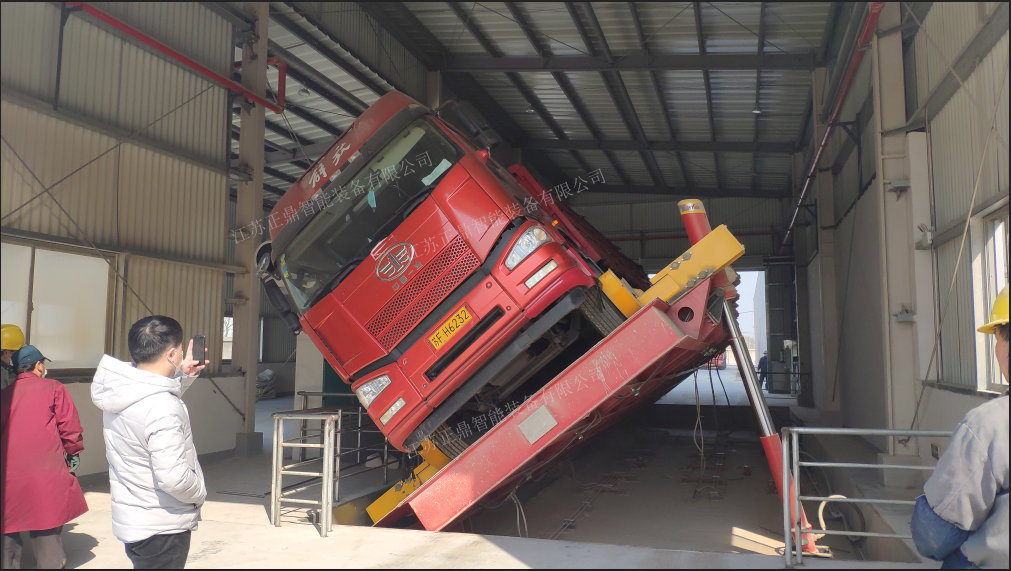Common Hydraulic Cylinder Failures in Truck Unloaders
Seal Degradation and Fluid Leaks
Degraded seals rank among the top reasons why hydraulic systems fail in those big truck unloaders at warehouses and distribution centers. When seals start to break down, they usually leak fluid which really messes with how well the whole system works. Most industry folks say standard seals typically hold up for around 2 to 5 years before needing replacement, though this varies quite a bit based on how hard they're worked, what kind of environment they're in, and whether regular maintenance gets done properly. Leaks from bad seals do more than just slow things down they actually create environmental problems too, plus companies end up spending a bundle replacing lost fluids and dealing with proper disposal costs. Checking seals regularly during routine maintenance helps catch issues before they become major problems, which saves both money and headaches later on. Keeping those seals in good shape extends the life of the equipment significantly while also reducing the need for expensive repairs down the road and minimizing any negative effects on the surrounding environment.
Cylinder Rod Scoring and Damage
Rod scoring remains one of the biggest headaches for hydraulic cylinder operators, usually caused by misalignment problems or when dirt gets into the system, which tends to cut down on how long the equipment lasts before needing replacement. When scoring happens, it creates extra friction that wears things down faster until eventually the whole system breaks down. Around 30% of all hydraulic system failures trace back to damaged rods according to industry reports. That's why regular inspections matter so much for keeping operations running smoothly. Keeping workshop areas clean and installing those protective covers over rods makes a big difference in preventing scoring issues. For companies working with truck unloading systems specifically, taking these steps means longer lasting equipment and fewer unexpected breakdowns that disrupt workflow and eat into profits.
Pump-Related Hydraulic Failures
In the realm of hydraulic systems, identifying pump-related failures is crucial for maintaining optimal functionality. When dealing with pumps, three core failure modes are important to recognize: Cavitation Due to Low Fluid Levels, Overheating and Viscosity Breakdown, and Contaminated Fluid Damage.
Cavitation Due to Low Fluid Levels
Cavitation poses a real problem for pumps when there's not enough fluid in the hydraulic reservoir. Studies show this issue can cut pump life short by around 80% and create all sorts of headaches during operation. What happens is air bubbles form inside the liquid and then pop suddenly, creating powerful shock waves that actually break down components over time. Keeping an eye on fluid levels regularly makes sense if we want to avoid cavitation altogether. This helps stop those sudden pressure changes that mess with how well the pump works. Installing sensors at low fluid levels turns out to be pretty good insurance against these problems. They give advance notice before things get bad and help maintain just the right amount of fluid needed for proper functioning.

Overheating and Viscosity Breakdown
Overheating remains a major issue for hydraulic systems, often causing problems with fluid viscosity. When this happens, the oil loses its ability to properly lubricate parts inside the system, resulting in increased friction and faster component wear. Industry data shows that when temps get too hot, hydraulic fluid life can drop by about half, seriously impacting how well the whole system works. To keep things running smoothly, operators need to manage heat either by installing proper cooling systems or checking fluid condition regularly. These steps help prevent breakdowns and maintain both viscosity levels and overall performance without relying on expensive replacements down the road.
Contaminated Fluid Damage
Fluid contamination remains one of those hidden problems behind many hydraulic system breakdowns. When fluids get dirty, they start wearing down components inside the system, which means mechanics spend far more time (and money) fixing things than they should. Some industry reports show that cleaning up after contaminated fluid damage often costs around five times what regular maintenance would normally require. The good news? Installing proper filtration equipment and sticking to recommended fluid change intervals goes a long way toward preventing these issues. Most plant managers find that keeping track of fluid quality pays off handsomely over time, both in terms of avoiding expensive repairs and getting better performance out of their machinery.
Control System Malfunctions
Valve Contamination and Blockages
Dirt and debris commonly cause valve contamination problems, which then leads to blockages that mess up how hydraulic systems work. Studies have shown that about 40% of all hydraulic system breakdowns actually come down to bad maintenance on these valves. Regular cleaning and checking of valves becomes really important if companies want to cut down on contamination issues and keep their systems running reliably over time. Going with better quality hydraulic fluids also helps lower the risk of contamination in valve systems, making everything run a lot smoother in practice.
Erratic Movements from Air Ingestion
When air gets into hydraulic systems, it causes all sorts of problems including jerky movements and system malfunctions that impact both safety and how well things run. Good design needs to address this issue head on if we want stable and dependable operation. Research shows that when there's air mixed in with the hydraulic fluid, performance drops around half sometimes, making equipment behave unpredictably during operation. To keep air out, proper sealing methods are essential along with routine inspections. These basic maintenance steps go a long way toward keeping hydraulic systems working at their best without unexpected failures.
Pressure and Flow-Related Problems
Insufficient System Pressure Symptoms
When system pressure drops too low, operators often notice things like actuators moving sluggishly or making jerky motions instead of smooth ones. These are warning signs something might be wrong with how the hydraulic system is functioning. Checking pressure regularly makes sense because catching problems early saves time and money down the road when bigger repairs become necessary. Some industry reports suggest keeping pressure within recommended ranges can boost overall system performance anywhere between 25-30%. For anyone running equipment where pressure matters, installing good quality pressure gauges along with automatic shut off mechanisms really pays off in the long run. Not only does this setup help avoid dangerous situations caused by low pressure, but it also keeps the whole system working properly for longer periods.
Fluid Foaming and Aerated Oil
When foam builds up inside hydraulic systems, it really cuts down on how well everything works and makes the whole thing run all over the place instead of smoothly. Most often we see this happening because there's dirt getting into the system or when things get too hot for too long, which messes with what the fluid is supposed to do. Studies from places like MIT have shown that keeping an eye on foam levels actually helps keep machines running reliably longer term since it stops the fluid from breaking down so fast. To tackle this problem, mechanics usually go two routes at once these days: adding special anti-foam stuff to the mix while also making sure the cooling system isn't letting temps spike anywhere near dangerous levels. These fixes help keep the oil flowing properly throughout the entire machine setup.
Restricted Flow in Lines and Fittings
When hydraulic lines get restricted, it usually causes all sorts of problems including lower efficiency and bigger pressure drops. Most of the time this happens because there are bends, kinks, or something blocking the pipe somewhere. Checking those lines and fittings regularly makes a big difference in catching these issues early before they turn into serious breakdowns down the road. Getting installation right from the start also helps avoid many of these flow problems altogether. Just following good practices during setup keeps everything running smoothly. Maintenance crews know this well since even small changes in how components are positioned can mean the difference between a system working properly or needing expensive repairs later on.
Preventive Maintenance and Solutions
Routine Inspection Protocols
Regular inspections really matter when it comes to catching problems before they actually happen. Studies show that keeping equipment well maintained can cut down on unplanned stoppages maybe around 20 to 25 percent, which means big savings over time and better output from operations. A good way to do this is through comprehensive checklists that walk through every part of the system step by step. These lists help spot what needs fixing right away and keep those hydraulic systems running longer than usual. Training workers properly matters too. When people know exactly what to look for during their checks, small issues get noticed early on instead of turning into major headaches later. So while nobody likes spending money upfront on maintenance, taking these steps makes sense in the long run because it prevents costly surprises and keeps everything working smoothly for years to come.
Proper Fluid Management Techniques
Getting fluid management right matters a lot for keeping hydraulic systems running smoothly. Testing fluids regularly should be part of any good maintenance routine because dirty or degraded fluid really messes with how well everything works. When contaminants build up in the system, all sorts of problems start happening that nobody wants to deal with during production hours. Keeping fluids at the right level and clean enough helps prevent those expensive breakdowns that stop work completely. Companies that set up solid fluid management practices tend to see their parts last longer before needing replacement. The systems just run better overall, which means fewer interruptions and lower repair bills down the road. Some shops report cutting maintenance costs by almost half after implementing proper fluid handling procedures across their operations.
Seal Replacement Procedures
Getting the hang of proper seal replacement is pretty important if we want to avoid breakdowns caused by worn out seals. Most folks in the industry recommend swapping out seals somewhere between two to five years based on what kind of environment they're working in. Keeping track of when these replacements happen makes sure maintenance stays regular and gives us something tangible to reference during quality checks. When maintenance crews get thorough training on how to replace seals correctly, it actually makes a big difference. The shop floor workers know this better than anyone else after all those late night repairs. Proper training stops those annoying hydraulic system issues before they start and keeps everything running smoothly day after day.
Pressure Testing Methodology
Pressure testing isn't just important it's absolutely necessary for finding weak spots in hydraulic systems before they cause problems. When companies run these tests regularly, they're basically checking if everything still works as it should according to specs. Good documentation around how often and what kind of pressure tests get done makes a big difference for both regulatory requirements and day-to-day reliability. Systems that undergo proper testing tend to perform better long term and save money on unexpected repairs down the road when parts finally give out from stress.
FAQ Section
What are the main causes of hydraulic failures in truck unloaders?
The main causes of hydraulic failures in truck unloaders include seal degradation, rod scoring, cavitation due to low fluid levels, overheating and viscosity breakdown, contaminated fluid damage, valve contamination, air ingestion, and restricted flow in lines.
How can I prevent seal degradation in hydraulic systems?
To prevent seal degradation, regular inspections for wear and damage are recommended. Maintaining optimal seal conditions and following seal replacement procedures also help to enhance system longevity and performance.
Why is fluid management crucial for hydraulic systems?
Fluid management is crucial for maintaining hydraulic system efficiency, as it ensures the quality and cleanliness of the fluid while avoiding contamination issues that can lead to significant maintenance costs.
What is the impact of cavitation on hydraulic systems?
Cavitation can significantly diminish pump lifespan, causing intense shock waves from air bubble collapses that damage system components, making regular monitoring of fluid levels essential.
How can I enhance the reliability of a hydraulic truck unloader?
Enhance reliability by implementing routine inspections, regular fluid testing, pressure testing, and maintaining clean and well-maintained hydraulic systems.

